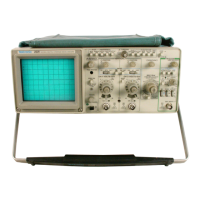Displaying Signals
Triggering on Complex or Non-Repetitive Signals
Some signals are too complex or irregular to provide a usable trigger of
there own. Circuits that carry digital information are a good example. Often,
however, a signal from another part of the circuit, such as a more widely
spaced clocking signal, will provide a meaningful trigger event. You can
even view the trigger signal at the same time as the other signal with a
two-channel display:
□ Step 1: Connect one signal to Channel 1 and the trigger signal to
Channel 2. Move the CHI BOTH CH2 switch to CH 2.
□
□
□
Step 2: Set the trigger mode to NORM and the SOURCE to CH 2.
Step 3: Adjust the TRIGGER LEVEL to trigger on the signal.
Step 4: Set the oscilloscope in STORE.
Step 5: Move the CHI BOTH CH2 switch to BOTH.
Step 6: Move the ADD ALT CHOP switch to ALT or CHOP. {In general,
it is better to use CHOP when the SEC/DIV control is set in the millisec
ond {ms) range, and ALT when the SEC/DIV is in the microsecond (ps)
range.)
□ Step 7: Position both signals on screen and adjust the vertical and
horizontal scales.
aU 1= 0.00V
i TRIG 2=i£
,5U aT=0|00u&
.
aU2 = 8,88U
I 1
.........
L i
_ L
!
__
i !
a
------
I
i ;
|
!
n
IV
—
\
:
m
I
j |
W
3T,T''Mr
....
T"
2U
2U
PEfiKDET Sus
Channel 2 (Trigger) Signal
Channel 1 Signal
Figure 3-26: Channel 1 Signal Triggered with Channel 2
The STORE mode is ideally suited for viewing extended {4K) acquisitions
and events that occur before during or after a trigger. Refer to Selecting the
Acquisition Record Length (1KI4K), page 3-15.
Triggering on Line Frequency
To trigger on power line signals, apply the signal to an input and move the
COUPL switch to LINE SOURCE.
2221A User Manual
3-27

